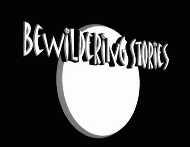Robinson Crusoe : After the Blast
by Mark Koerner
Many people know Daniel Defoe’s Robinson Crusoe as a boys’ adventure tale. Others spoil it by analyzing it as a work of great literature. But the loose freemasonry of this planet’s science fiction community knows better: they know that Robinson Crusoe is the greatest after-the-blast story ever written, and a sober warning to us all about the need to avert thermonuclear war.
It deserves an honored place on every SF bookshelf, right next to Walter Miller’s A Canticle for Liebowitz and Pat Frank’s Alas, Babylon.
Robinson Crusoe begins in the year 1632 — that is, one thousand six hundred and thirty-two years after the world was destroyed in a thermonuclear holocaust. Mankind has slowly rebuilt civilization, creating a world where ships are powered not by engines but by giant sails, and everyone professes to believe in a most unpleasant type of religious fanaticism. Unlike our own society, everyone is very status conscious, very aware of their place in the pecking order — obviously a result of the centuries of scarcity mankind faced after the blast.
Every schoolboy knows the basic outlines of what happened to young Robinson: he “goes to sea,” gets shipwrecked, and lands on a lush, fertile island — which he keeps referring to as a “desert” island. (“Where are the cacti?” we might ask.) At any rate, in a recapitulation of what the survivors went through in the immediate aftermath of the blast, Crusoe must become a scavenger himself, making constant trips to his crippled ship for rope, boards, burlap bags, and canned goods. Slowly, he achieves a certain level of comfort.
But just as Crusoe is settling down to a contented, reasonably comfortable life, he sees a footprint in the sand. “Cannibals,” he says. Even the word terrifies him. He learns that cannibals have been making occasional trips to his island. Although Defoe is vague on the origin of these cannibals, it is clear to any careful reader that they are the descendants of the starving people who had to live on human flesh after civilization destroyed itself. But Defoe does make it clear that whatever justification once existed for this behavior is no longer valid. The cannibals must be fought, and if possible, killed.
When Crusoe gets the chance, he kills a few cannibals, and in the process rescues a man who would have been part of their feast. But instead of greeting the island’s new resident as a man and a brother, Crusoe renames him “Friday” (as if Friday didn’t have a name of his own) and makes him his slave. The fact that Crusoe sees this as part of the natural order of things is Defoe’s way of showing that the road back to civilized morality will be long, slow, and tortuous.
In the end, Crusoe gets rescued, and he and Friday go back to England in one of the ships powered by giant sails. And, in the end, too, the U. S. and the USSR never went to war with each other, so no one will ever have to live in the world that Defoe warned us against.
Although it’s hard to prove that Defoe’s classic had anything to do with keeping the peace, it is worth noting that Robinson Crusoe was never banned in the Soviet Union. Thinking about Crusoe’s world, his hardships, and the cannibals may have made more than one Soviet leader — and more than one American leader — step back from the brink. If this is indeed the case, then all we can say is: Thank you, Dan Defoe.
Copyright © 2004 by Mark Koerner

